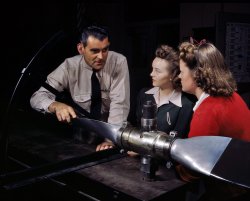
MAY CONTAIN NUTS

Search Shorpy
SHORPY ART

Framed or unframed, desk size to sofa size, printed by us in Arizona and Alabama since 2007. Explore now.
Join and Share
Ad-Free Shorpy
Shorpy is funded by you. Patreon contributors get an ad-free experience.
Learn more.

Recent comments
- What a headache!
- Baldwin 62303
- Baldwin VO-1000
- Cold
- No expense spared
- Tough Guys
- Lost in Toyland
- And without gloves
- If I were a blindfolded time traveler
- Smoke Consumer Also Cooks
- Oh that stove!
- Possibly still there?
- What?!?
- $100 Reward
- Freeze Frame
- Texas Flyer wanted
- Just a Year Too Soon
- WWII -- Replacing men with women at the railroad crossing.
- Yes, Icing
- You kids drive me nuts!
- NOT An Easy Job
- I wonder
- Just add window boxes
- Icing Platform?
- Indiana Harbor Belt abides
- Freezing haze
- Corrections (for those who care)
- C&NW at Nelson
- Fallen Flags
- A dangerous job made worse
Member Photos
The Shorpy
Print Emporium
Print Emporium
Search Shorpy
Search results -- 30 results per page
- Inglewood: 1942
- ... View full size. 4x5 Kodachrome transparency by Alfred Palmer, Office of War Information.
Grandma I am almost 100% certain that ... Posted by Dave - 08/30/2012 - 12:02pm -
![Inglewood: 1942 October 1942. Assembling switchboxes on the firewalls of B-25 bombers at North American Aviation's Inglewood, California, factory. View full size. 4x5 Kodachrome transparency by Alfred Palmer, Office of War Information.
GrandmaI am almost 100% certain that this is a picture of my grandmother.
[What year was she born? - Dave]
KodachromeThe photo is of such good quality, it's almost like you're standing behind her.
(The Gallery, Kodachromes, Alfred Palmer, Aviation, WW2)](https://www.shorpy.com/files/images/1a35311u.thumbnail.jpg)
- Model Behavior: 1942
- ... bomber. View full size. 4x5 Kodachrome transparency by Alfred Palmer.
too good to be a job This had to be a publicity shot, right? ... Posted by Ken - 08/05/2012 - 9:30am -
![Model Behavior: 1942 October 1942. Experimental staff at the North American Aviation plant in Ingle- wood, Calif., observing wind tunnel tests on a model of the B-25 ("Billy Mitchell") bomber. View full size. 4x5 Kodachrome transparency by Alfred Palmer.
too good to be a jobThis had to be a publicity shot, right? The lighting, not to mention the clothes, are way too perfect for this to be a day-to-day candid photo.
[Alfred Palmer often used an auxiliary light, which can be seen in the corner of some of his photographs. Here and here, for example. None of these were "publicity shots." Used as studies for government poster art, they were taken for the Office of War Information and are in the Library of Congress archives. After funding for the OWI/FSA photography program was cut in 1943, many of these pictures never saw the light of day. Until now. - Dave]
B-25 Mitchellthe B-25 may have been named for Gen Billy Mitchell, but I've never seen it referred to as the 'Billy Mitchell'.
(The Gallery, Kodachromes, Aviation, WW2)](https://www.shorpy.com/files/images/1a35316u.thumbnail.jpg)
- Let's Roll: 1941
- ... for combat duty." View full size. 4x5 negative by Alfred Palmer for the Office of War Information.
Taxpayer Ripoff Notice the ... Posted by Dave - 07/27/2011 - 12:04pm -
![Let's Roll: 1941 December 1941. White Motor Company, Cleveland. "Halftrac scout cars ready for the Army except for the addition of certain pieces of Army equipment. The cars as they stand in the yard of a Midwest manufacturer are ready for combat duty." View full size. 4x5 negative by Alfred Palmer for the Office of War Information.
Taxpayer RipoffNotice the side "windows" are gone from the effects of sunlight and ozone.
[Look closer. The brand-new plastic side curtains are 100% intact. The light part is a reflection of the sky; there's caulk (?) around the edges. - Dave]
A Stitch In TimeThe vehicles on the right are M2 or M3 halftracks. White produced 15,414 for the war department. Autocar, IH, and Diamond T made them also, to make a total of ~43,000 produced for the war effort.
When sewn, the soft clear window material is protected by paper to eliminate scratching. The white remnants are from this paper. (I've stitched up a few soft tops and convertible top windows in my day.)
(The Gallery, Alfred Palmer, Cars, Trucks, Buses, Cleveland, WW2)](https://www.shorpy.com/files/images/8e10717u_0.thumbnail.jpg)
- Mobilized: 1942
- ... to scenes of action." 4x5 inch acetate negative by Alfred Palmer for the Office of War Information. View full size.
Lunch Boxes ... Posted by Dave - 11/04/2021 - 3:30pm -
![Mobilized: 1942 October 1942. "Great numbers of C-47 transport planes move along the assembly lines at the Douglas Aircraft Company plant at Long Beach, California. The versatile C-47 performs many important tasks for the Army. It ferries men and cargo across oceans and mountains, tows gliders and brings paratroopers and their equipment to scenes of action." 4x5 inch acetate negative by Alfred Palmer for the Office of War Information. View full size.
Lunch BoxesI carried one of those for almost 35 years. When I retired, my wife gave it away without telling me. Horror! I still loved her.
Big BizWars are certainly good for industry. The sheer volume of aircraft, tanks, guns, ships, freight trains, trucks, armored vehicles, submarines, ammunition, bombs, etc, and all its infrastructure, produced in short order from all sides was staggering.
Smoke 'em if you got 'emPretty sure that's a cigarette machine under the left wingtip.
The Gooney BirdArguably (but not for me) the greatest aircraft ever built.
This Could Be One of Those PlanesWith what I believe is a C-47 behind them, this is my father when he was on a war bond tour in September 1943. He had served early in the war as a tank commander in North Africa and was injured. Because of his war record he was selected to accompany several movie stars of the time to help sell war bonds. My father is the army man kneeling in front. The lady directly behind him is an actress named Helen Walker. Next to her is Albert Dekker, of Dr. Cyclops fame. The lady to the right of him is actress Elyse Knox. She would later be married to Tom Harmon and is the mother of Mark Harmon.
Plate or door?What is that square plate or door above the pilot's station on the top of the fuselage? Some kind of door? A plate covering some kind of electronic equipment?
The round one that's inboard and aft a bit is for the Navigator's acrylic dome I believe.
Clean plant!Can you imagine in today's world trying to mobilize like America did in WWII?
Railroads trying to handle the traffic? For that matter, just the people bonding together.
Unbelievable output by our factories, many repurposed to produce war materiel.
Amazing.
The Old DaysWhen you could find a cigarette machine in your workplace conveniently near where your locker and lunch are located.
Gooney BirdsWas the affectionate term for the venerable C-47. A quarter century after this photo the Air Force gave me my first (uncomfortable) airplane trip in one of them.
The plate above the flight deck is an escape hatch. What is known as an "astrodome" was, indeed, a plexiglass dome for the navigator to take celestial bearings.
Food safety?I would hope all those lunch boxes we're seeing on top of the lockers are there post-lunch instead of pre-lunch. Maybe refrigeration wasn't that big of a concern back then.
[What planet did you grow up on? You are evidently not one of the eighty zillion schoolkids who ate from unrefrigerated lunchboxes back in the day. - Dave]
(The Gallery, Alfred Palmer, Aviation, Factories, WW2)](https://www.shorpy.com/files/images/SHORPY-8b05587u.thumbnail.jpg)
- Annette Del Sur: 1942
- ... collected at the plant." 4x5 Kodachrome transparency by Alfred Palmer. View full size.
Two Sharp Things Two sharp things: (1) the ... Posted by Dave - 08/04/2012 - 11:06pm -
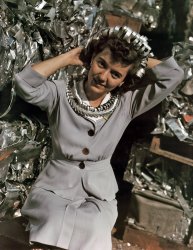
- Pistons Aplenty: 1942
- ... Inc., Cincinnati." Medium format nitrate negative by Alfred Palmer for the OWI. View full size.
Zollner Pistons I see that these ... Posted by Dave - 07/29/2012 - 2:39pm -
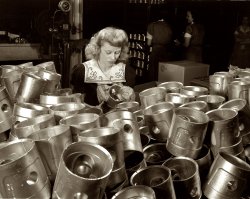
- Parris Island: 1942
- ... tools." View full size. 5x7 safety negative by Alfred Palmer.
Vaccination scar Is that a vaccination scar on his upper arm?
... Posted by Dave - 07/27/2012 - 1:48pm -
![Parris Island: 1942 May 1942. "When a husky leatherneck throws his weight on a line, things come his way. A member of a Marine barrage balloon unit in training at Parris Island, South Carolina, helps to ground one of the big bags that the Corps has added to its kit of fighting tools." View full size. 5x7 safety negative by Alfred Palmer.
Vaccination scarIs that a vaccination scar on his upper arm?
[That's what it looks like. Smallpox maybe. - Dave]
Parris Island MarineLooks like he is wearing a rosary around his neck. Not sure of the object on a rawhide cord. If it's a dogtag, it's unusual.
My uncle trained at Parris Island in early 1942. Went from there to the South Pacific and the invasion of Guadalcanal.
Re: NecklaceMaybe it IS a dogtag with the rawhide cord threaded through two opposing holes.
[I think you're right. See above for the flipside. - Dave]
NecklaceMy first thought was that it looks like some kind of specialized tool (P-38 Can Openeresque?), but since the rawhide cord is so short, it wouldn't easily lift over his head if he needed it. Hope someone knows what it is????
[Below, a close-up. - Dave]
DogtagsIt's the same as the two tags seen here on the Marines at Camp LeJeune. Detail of the left one below.
Not a rosaryRosaries always have a series of 10 beads, than a single bead, then 10 more, which is repeated (almost always) a total of 5 times. It's possible to have 15 sets of 10+1 beads rather than 5, but very unusual (it would be really long), and in any event, they are ALWAYS sets of 10 (called "decades") + a single. The Marine's chain is in sets of 7.
Q.E.D.: This string of beads is not a rosary.
I'll also add that it is considered highly improper to wear one around your neck like this. That doesn't stop people from doing it nowadays in the post-Madonna era, but it would be *really* frowned upon for Catholics in the 1940s. In those years, it's not too likely a non-Catholic would adopt any Catholic articles as a "fashion statement" either.
Hot.Hot.
Religious medalMight they be medals of St. Christopher or another saint? There appear to be embossed or raised objects on the flat bits. The shape and size seem about right. It's interesting, he is muscular but some of today's marines could pick him up with one arm! Hope he got through it 0K!
Re: Not A RosarySid: An Anglican rosary is made up of twenty-eight beads divided into four groups of seven called weeks. Perhaps this is an Anglican rosary? I don't know what it is.
Vaccination ScarLots of us old geezers have them, right in the same spot too. It's pretty much a mark of anyone born before, say, 1965 or whenever smallpox was wiped out. I can vaguely remember getting mine sometime around 1963; there was a big push to get everyone immunized.
Not a Rosary, but a ChapletThis very well could be a chaplet, which is a set of Roman Catholic prayer beads, *like* a Rosary, but for other personalized prayer meditations.
This sure as heck looks like a Seven Dolors Chaplet -- a Chaplet of the Seven Sorrows, in honor of Our Lady’s Sorrows.(The Seven Sorrows is a series of meditations on the sufferings of Mary as the Mother of Jesus.)
http://en.wikipedia.org/wiki/Chaplet_%28prayer%29
http://en.wikipedia.org/wiki/Our_Lady_of_Sorrows
pictures of RC prayer beads (modern)
http://www.sistersofcarmel.com/chaplets.php
http://www.sistersofcarmel.com/chapletsd.php
and it looks almost *exactly* like this one!!
I would guess that this guy has the center dangling part of the beads draped down his back so it doesn't get in the way of his work.
A chaplet worn like this would not be disrespectful, it would be worn 24-7 as a spiritual protection, and/or as a sign of special devotion or dedication to the Virgin Mary.
[Thank you! - Dave]
Dog TagIt looks like two tags together on a rayon cord. I've read the rayon cord was a common way to wear the dog tag. The shape of the tags are similar to a Navy dog tag I have from WW II.
RE: Vaccination ScarInteresting - Everyone in our unit had to get the smallpox vaccination in Kuwait while awaiting the green light for Operation Iraqi Freedom in 2003. My scar is about half the size of the one in the picture.
HotnessLook another candidate for the Hot Guys gallery (you know, the Pretty Girls get a gallery I think it's only fair the guys get one. The crew team should go in as well).
[We already have such a gallery. And this boy is now in it. - Dave]
Handsome RakesRockin' Thanks Dave!
(The Gallery, Alfred Palmer, Aviation, Handsome Rakes, WW2)](https://www.shorpy.com/files/images/8e09040u1.thumbnail.jpg)
- Thingamabobs for Victory: 1943
- ... Nashville division." 4x5 Kodachrome transparency by Alfred Palmer. View full size.
ha! Love your title for this one.
Gracie ... Posted by Dave - 07/22/2012 - 12:42pm -
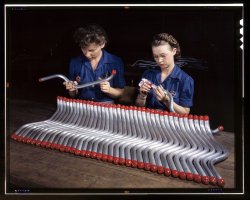
- 568 + 532 = B-25
- ... View full size. 4x5 Kodachrome transparency by Alfred Palmer for the Office of War Information.
The Old Math It took me a ... Posted by Dave - 08/10/2012 - 7:51pm -
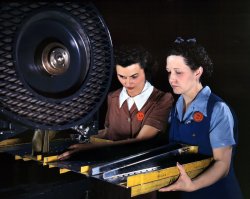
- Tankers: 1942
- ... View full size. 4x5 Kodachrome transparency by Alfred Palmer, Office of War Information.
Light My Fire The gasoline powered ... Posted by Dave - 08/05/2012 - 10:54am -
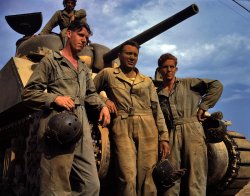
- Fort Knox: 1942
- ... View full size. 4x5 Kodachrome transparency by Alfred Palmer, Office of War Information.
A triumph for democracy, and for ... Posted by Dave - 08/03/2012 - 10:31pm -
![Fort Knox: 1942 June 1942. M-3 tank in action at Fort Knox, Kentucky. View full size. 4x5 Kodachrome transparency by Alfred Palmer, Office of War Information.
A triumph for democracy, and for KodachromeTeam Shorpy - Any chance of our seeing what this image looked like before color correction?
This is a great shot, and I am intrigued by the conditions under which it was taken. I do not think color films in 1942 were very quick; this was probably shot on what would today be called iso 25 or iso 50 film. However, the dust clouds and tank treads are frozen, so the shutter speed may have been 1/250 or even faster. Palmer got pretty good depth of field too -- several feet at least. That combination suggests that this photo was taken in very bright sunlight.
Traditionally, such a dark blue sky suggests that a polarizing filter was used, but that would have cut down on light and Palmer needed all the light he could get for this shot. Was it enhanced in Photoshop?
I wonder if this tank would have seemed impressive or threatening to viewers of this photograph in 1942. To my eye, it looks cute, but perhaps that's the result of decades of exposure to much larger and more dangerous machines.
[Original image below. - Dave]
Central Harlem's Uniformed QuestionIn 1942 Kodachrome had a film speed of Weston 8 which corresponded EXACTLY to ASA 10, which corresponds exactly to ISO 10. There is no reason to believe that Kodachrome would have suffered any color deterioration WHATEVER since this image was processed and stored in 1942, so the colors you see here are probably exceedingly close to what you they were in 1942, allowing for the vagaries of present-day scanning, conversion to digital electronic format, and display. The colors as presented here are typical of what can be seen from properly stored Kodachrome transparencies from the 1940s, perhaps originally exposed through a polarizer, though not necessarily. Consult the Wikipedia article on Kodachrome for more on all this.
[So, what kind of uniform does a "uniformed" question wear? Dress blues? Irritating, obtuse comment of the day. But the day is young! - Dave]
The TankAs far as Central Harlem Anonymous's question as to whether "this tank would have seemed impressive or threatening to viewers of this photograph in 1942," the answer is that to the uninformed viewer it would have seemed quite impressive, but to anyone who had much knowledge about armor it would not be well regarded at all. The M-3 - known to the British as the General Lee - was pretty much obsolescent when it came off the production line. The 75 mm main gun is impressive enough but it is mounted in a sponson on the right side of the tank's hull giving it a limited field of fire of about 15 degrees to the right or left of center. The secondary gun, a 37 mm turret mounted gun (in this tank either removed, not mounted or cut off) was a fairly decent gun but didn't have the striking power of the guns that even the German Panzer IV had. And that was weak compared to what the Tiger Tanks that the Germans were producing had. The turret itself is a disaster - far too high and a very inviting target. The British bought a large number of the M-3s to cover their own shortfalls in tank production and the first thing they did was to replace the turret with a lower one of their own design. The result was the "General Grant" which was one of the main tanks of Montgomery's Eighth Army at the Battle of El Alamein. The Grants and Lees were taken out of service by the time of the invasion of Sicily, though some were used by the British in the Burma theater of operations where the Japanese tanks were truly pathetic. The Russians were given some through Lend-Lease; they referred to the Lee as "a coffin for seven brothers." Of course by this time the Russians were operating the beautiful T-34. The US Army would eventually use the body of the M-3, heavily modified, to create a self propelled gun type, the M-7 Priest.
(The Gallery, Kodachromes, Alfred Palmer, WW2)](https://www.shorpy.com/files/images/1a35204u1.thumbnail.jpg)
- Inglewood: 1942
- ... View full size. 4x5 Kodachrome transparency by Alfred Palmer for the Office of War Information.
Dandy This guy is really ... Posted by Dave - 08/03/2012 - 11:34am -
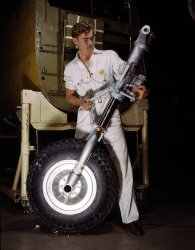
- Watch the Fingers: 1942
- ... View full size. 4x5 Kodachrome transparency by Alfred Palmer.
Clean She has a nice hairdo, perfect lipstick, nice teeth, and ... Posted by Dave - 08/30/2012 - 2:00pm -
![Watch the Fingers: 1942 October 1942. Metal parts are placed on masonite by this employee before they slide under the multi-ton hydropress at North American Aviation in Inglewood, California. View full size. 4x5 Kodachrome transparency by Alfred Palmer.
CleanShe has a nice hairdo, perfect lipstick, nice teeth, and is all clean and neat except the hands. Maybe this is a commercial for hand lotion.
Hydropress-O-MaticThe way she is smiling maks this photo look like a commercial. "Would you like to place metal parts on masonite? It sure is tons of fun!"
Some Staging (*)I have done work like that and it is quite possible to have filthy hands only. (I tend to rub my nose so I always get a nice stripe there as well.)
The lower part of her smock is hidden in shadows but I suspect it matches her hands.
All of these nice Kodachrome prints of women working on the war effort are staged to a degree. It may be the worker doing her job, but by the time you set up the lights and the tripod it is not going to be candid.
I have also noticed in some of the previous photos that there was no actual work being done.
[Posed, not "staged." There's a big difference. As we've pointed out elsewhere on this site, many of these large-format Kodachromes were made as studies for poster illustrations (example below). They were never intended as candid shots of people at work. - Dave]
(The Gallery, Kodachromes, Alfred Palmer, Aviation, WW2)](https://www.shorpy.com/files/images/1a35307u.thumbnail.jpg)
- Fort Knox: 1942
- ... View full size. 4x5 Kodachrome transparency by Alfred Palmer, Office of War Information.
(The Gallery, Kodachromes, Alfred ... Posted by Dave - 08/09/2012 - 12:34pm -
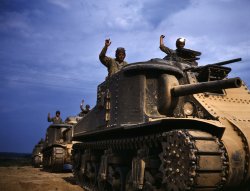
- Bethlehem-Fairfield: 1941
- ... View full size. Medium format nitrate negative by Alfred Palmer.
Wow. Just wow. Cool. Girders in the haze.
(The Gallery, ... Posted by Dave - 07/23/2012 - 6:42pm -
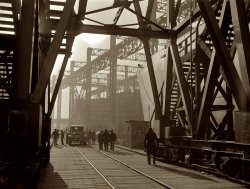
- Student Driver: 1942
- ... Knox, Kentucky." 4x5 inch Kodachrome transparency by Alfred Palmer for the Office of War Information. View full size.
Re: Stuart M3 ... Posted by Dave - 04/05/2014 - 3:37pm -
![Student Driver: 1942 June 1942. "Light tank, Fort Knox, Kentucky." 4x5 inch Kodachrome trans­parency by Alfred Palmer for the Office of War Information. View full size.
Re: Stuart M3 Light TankMy father always said these tanks were death traps. They sustained many casualties against the Germans in those early battles in North Africa. The German tanks were far superior. It wasn't until the introduction of the M4 Sherman tank that we had something that could compete.
Yank in a TankMy father trained at Fort Knox before the war started and was in the first battles fought in North Africa in 1942. He commanded an M3 light tank. This is a photo taken during their training days. My father is the one in the turret at the top. This looks like the same type of tank in today's post.
Quandary Did 'Sarge' say the first left or the second left?
A Few Good MenLooks like Gomer Pyle, but he was a Marine.
Stuart M3 Light TankThat's what it appears to be.
Here's a link to a running, if somewhat worse for wear version.
https://www.youtube.com/watch?v=URclSaYDFwA
War Is HellHere's another shot of an M3 Stuart illustrating how dangerous they could be when hit. Not sure if this was during pre-war training or in North Africa. My father's note on the back only says, "A tank on fire."
Incendiary nicknameWW2 GIs had an unkind nickname for US tanks..."Ronson" after the popular cigarette lighter, whose catch phrase was "lights up first time, every time", referring to how quickly the gasoline-powered tanks caught fire when hit by the Germans.
On a similar note, several versions of the later M4 Sherman were equipped with a flame thrower [and were widely used in the Pacific]--these flame tanks were known as "Zippos".
SirenNote the siren next to the assistant driver's bow machine gun. Just above it you can see the end of the sponson machine gun. These were later eliminated on the M3A1.
(The Gallery, Kodachromes, Alfred Palmer, WW2)](https://www.shorpy.com/files/images/SHORPY_1a35213u1.thumbnail.jpg)
- Ready to Roll: 1942
- ... base. View full size. 4x5 Kodachrome transparency by Alfred Palmer, O.W.I.
Camp Lejeune New River flows through a large USMC base ... Posted by Dave - 07/24/2012 - 9:37pm -
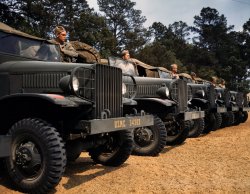
- Douglas Dam: 1942
- ... Dam. View full size. 4x5 Kodachrome transparency by Alfred Palmer.
Kodachrome again.. I still can't get over how I can instantly ... Posted by Dave - 08/30/2012 - 12:01pm -
![Douglas Dam: 1942 June 1942. Construction work at the Tennessee Valley Authority's Douglas Dam. View full size. 4x5 Kodachrome transparency by Alfred Palmer.
Kodachrome again..I still can't get over how I can instantly tell a Kodachrome on your site, and how amazingly crisp and colorful they are. Even a pic of a muddy construction site is so sharp and clear, it's a thing of beauty!
I also love how the Kodachrome's crispness and clarity gives you a you-are-there feeling, looking at one from the 1940's or 50's. So vivid and sharp.
Feats of Civil EngineeringMy late grandpa used to work on dam sites just like this one, albeit probably a bit smaller, in Finland in the late forties, early fifties. He was a Marion operator, driving one of those monstrous backhoes that could pick up a small car in one fell... scoop. He used to transport workmen across the river in the scoop itself. It held eight cubic meters, he insisted.
Makes one wonder about these great feats of civil engineering, accomplished by such small creatures as men with a lot of planning and some big machines. A lot was done by hand, too, where these days we have strange machines and novel ways of molding concrete pours and advanced reinforcement techniques.
But man, that is one huge site!
[They had their share of strange machines back then, too. Below is another view of the same work site. - Dave]
(The Gallery, Kodachromes, Alfred Palmer, Industry & Public Works, WW2)](https://www.shorpy.com/files/images/1a35261u.thumbnail.jpg)
- TVA: 1942
- ... River. View full size. 4x5 Kodachrome transparency by Alfred Palmer, Office of War Information.
Fark-welding More recent Farkage. ... Posted by Dave - 08/08/2012 - 8:18pm -
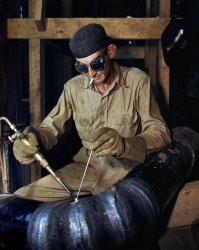
- Paging Rosie: 1942
- ... (With, yes, a power drill.) 4x5 Kodachrome transparency by Alfred Palmer, Office of War Information. View full size.
Staying feminine ... Posted by Dave - 08/21/2012 - 8:34pm -
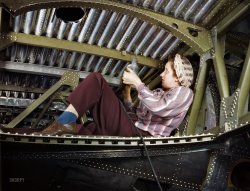
- On the Edge: 1942
- ... View full size. 4x5 Kodachrome transparency by Alfred Palmer for the Office of War Information.
(The Gallery, Kodachromes, Alfred ... Posted by Dave - 08/09/2012 - 12:34pm -
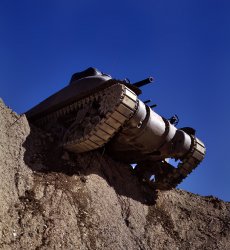
- Lighter Than Air: 1942
- ... View full size. 4x5 Kodachrome transparency by Alfred Palmer.
Why the fins? Why does a barrage balloon need tailfins? It ... Posted by Dave - 08/10/2012 - 4:54pm -
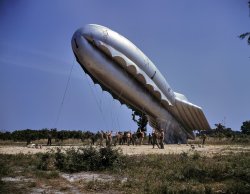
- Speed Racer: 1941
- ... the exacting specifications of the Army." 4x5 negative by Alfred Palmer. View full size.
Giving my etymological chassis a workout I ... Posted by Dave - 09/30/2017 - 9:18pm -
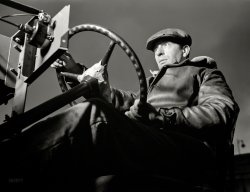
- War Clouds: 1942
- ... of a series of chemical-plant smokestacks photographed by Alfred Palmer in Muscle Shoals, Alabama, and Akron, Ohio, in 1942. View full size. ... Posted by Dave - 08/09/2012 - 12:35pm -

- Heavy Duty: 1941
- ... Ohio." View full size. 4x5 nitrate negative by Alfred Palmer for the Office of War Information.
(The Gallery, Alfred Palmer, ... Posted by Dave - 07/30/2012 - 11:23pm -
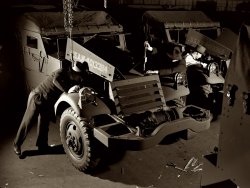
- Not a Cloud in the Sky: 1942
- ... the airman seen here . 35mm Kodachrome transparency by Alfred Palmer, Office of War Information. View full size.
Aircraft No way ... Posted by Dave - 06/13/2008 - 8:19pm -
![Not a Cloud in the Sky: 1942 May 1942. Parris Island, South Carolina. "Marine lieutenant glider pilot in training at Page Field." A smilier version of the airman seen here. 35mm Kodachrome transparency by Alfred Palmer, Office of War Information. View full size.
AircraftNo way the aircraft is a "glider." It looks to me like a BT-13 "Valiant" basic trainer, designated an SNV in the Navy and USMC.
[It's a tow plane that pulls the training gliders. - Dave]
An obscure chapter of Parris Island historyThe BT-13 has a triangular window aft of the rear canopy; this one doesn't. Compare to this BT-13 http://ww2db.com/image.php?image_id=3768
The picture is probably an SNJ (Navy/Marines version of North American AT-6). Here's a whole string of photos from that time and place including the same guy http://www.flickr.com/photos/library_of_congress/2179093655/in/set-72157...
The Marine Corps Glider Group 71 was an unusual experiment for the Marines. After watching the Germans take Holland in 1940 with gliders, the Marines thought some catching up was in order, so they set up a glider training group at Parris Island in 1942. After a year, it was shut down when they realized it would not be effective in the Pacific theatre against the Japanese. Today Page Field is thick with vegetation and no longer has aircraft, but is used as a training ground for Marine recruits. Each Marine must pass a greuling multi-day combat trial at Page Field known as "The Crucible" in order to become a US Marine.
(The Gallery, Alfred Palmer, Aviation, WW2)](https://www.shorpy.com/files/images/1a35149u.thumbnail.jpg)
- A Watched Pot: 1942
- ... View full size. 4x5 Kodachrome transparency by Alfred Palmer for the Office of War Information.
Muscle Shoals has got the ... Posted by Dave - 08/13/2012 - 3:59pm -
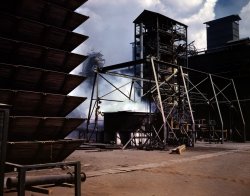
- Vengeance: 1943
- ... View full size. 4x5 Kodachrome transparency by Alfred Palmer.
(The Gallery, Kodachromes, Alfred Palmer, Aviation, WW2) ... Posted by Dave - 08/05/2012 - 9:28am -
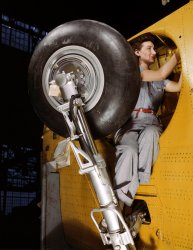
- Making Sparks Fly: 1942
- ... View full size. 4x5 Kodachrome transparency by Alfred Palmer.
(The Gallery, Kodachromes, Alfred Palmer, Factories, WW2) ... Posted by Dave - 08/07/2012 - 4:48am -
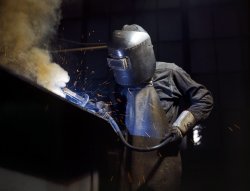
- Propellers 101
- ... class. View full size. 4x5 Kodachrome transparency by Alfred Palmer, Office of War Information.
(The Gallery, Kodachromes, Alfred ... Posted by Dave - 08/30/2012 - 2:00pm -
